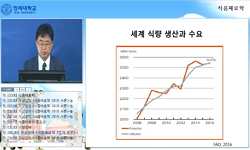The production scale of mushrooms in Korea is approximately 600 billion won, which is 1.6% of Korea's gross agricultural output. In Korea, ca. 190,000 tons of mushrooms are harvested annually. Although the numbers of mushroom farms and cultivators are...
http://chineseinput.net/에서 pinyin(병음)방식으로 중국어를 변환할 수 있습니다.
변환된 중국어를 복사하여 사용하시면 됩니다.
- 中文 을 입력하시려면 zhongwen을 입력하시고 space를누르시면됩니다.
- 北京 을 입력하시려면 beijing을 입력하시고 space를 누르시면 됩니다.

Introduction of the representative mushroom cultivars and groundbreaking cultivation techniques in Korea
한글로보기https://www.riss.kr/link?id=A105704386
- 저자
- 발행기관
- 학술지명
- 권호사항
-
발행연도
2016
-
작성언어
English
-
주제어
mushroom ; cultivar ; cultivation ; spawn
-
등재정보
KCI등재
-
자료형태
학술저널
-
수록면
136-141(6쪽)
- 제공처
-
0
상세조회 -
0
다운로드
부가정보
다국어 초록 (Multilingual Abstract)
The production scale of mushrooms in Korea is approximately 600 billion won, which is 1.6% of Korea's gross agricultural output. In Korea, ca. 190,000 tons of mushrooms are harvested annually. Although the numbers of mushroom farms and cultivators are constantly decreasing, total mushroom yields are increasing owing to large-scale cultivation facilities and automation. The recent expansion of the well-being trend has caused an increase in mushroom consumption in Korea: the annual per capita mushroom was 3.9 kg ('13), whichis a little higher than that in Europe. Thus, mushroom export, mainly Flammulina velutipes and Pleurotus ostreatus, has increased since the mid-2000s. Recently, however, it is slightly reduced. Nevertheless, Vietnam, Hong Kong, the United States, and the Netherlands continue to export mushrooms, and Korea has increased its export to Australia, Canada, Southeast Asia, etc. Canned Agaricus bisporus, the first export of the Korean mushroom industry, reached it speak sales in 1977-1978. When Korea initiated trade with China in 1980, the international prices of mushrooms fell sharply, leading to shrinkage of the domestic markets. Spurred by the high demand to develop substitute goods for A. bisporus, the oyster mushroom (P. ostreatus) gained attention since it seemed to suit the taste of Korean consumers. Although the log cultivation technique for oyster mushroom was developed in the early 1970s, it required a great deal of labor. Thus, we developed the shelf cultivation technique, which is easier to manage and allows for mass production. In this technique, the growing shelf is made mafrom fermented rice straw, whichis the only P. ostreatus medium in the world and isused only in South Korea. After then, the use of cotton wastes as an additional material of medium, the productivity. Currently, we are developing a standard cultivation technique and environmental control system that can stably produce mushrooms throughout the year. The increase of oyster mushroom production may boostthe domestic market and contribute to industrial development. In addition, oyster mushroom production technology played a role in forming the basis for the development of bottle cultivation, which made mass production. In particular, bottle cultivation using liquid spawn could allow for the export of F. velutipes and Pleurotus eryngii. In addition, the white varieties of F. velutipes were second developed in the world after Japan. We also developed the new A. bisporus cultivar 'Saeah', which is easy to grow in Korea. In hopes to advance the mushroom industry, we will continue to develop cultivars with international competitive power and to improve cultivation techniques.
동일학술지(권/호) 다른 논문
-
Cellulase from the fruiting bodies and mycelia of edible mushrooms : A review
- 한국버섯학회
- Yuanzheng Wu
- 2016
- KCI등재
-
- 한국버섯학회
- Kab-Yeul Jang
- 2016
- KCI등재
-
- 한국버섯학회
- 유영복
- 2016
- KCI등재
-
- 한국버섯학회
- Kyeong Hun Park
- 2016
- KCI등재




 ScienceON
ScienceON


